The Statues Of Liberty – Five Examples Of Lady Liberty In Paris
There she stands on her island, tall on a pedestal, torch held high looking over the body of water beneath her feet, wearing a crown as she strides forward. Liberty Enlightening the World she is formally named, but most of us know her as the Statue of Liberty. And the body of water is, of course — the Seine River in Paris.
![]()
Discover What's On When You're Here...
• January... |
• February... |
• March... |
• April... |
• May... |
• June... |
• July... |
• August... |
• September... |
• October... |
• November... |
• December... |
Discover What's On When You're Here
• January...
|
• February... |
• March... |
|---|---|---|
• April... |
• May... |
• June... |
• July... |
• August... |
• September... |
• October... |
• November... |
• December... |
La Femme with the Flame
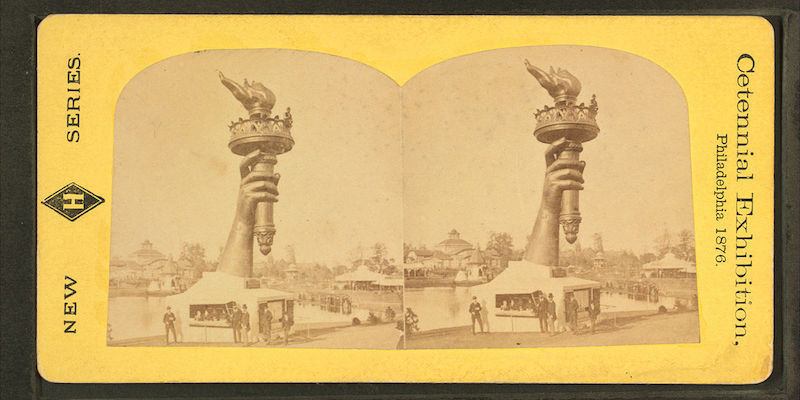 The hand and flame were the first parts of the statue to be created
The hand and flame were the first parts of the statue to be created
The Statue of Liberty is most well known for its impressive presence in New York Harbor. But did you know there are at least five large, authentic models of the Statue of Liberty in Paris? Which makes sense when you remember that it was a joint Franco-American project celebrating the friendship between the two nations.
A Short Chronicle of the Statue of Liberty
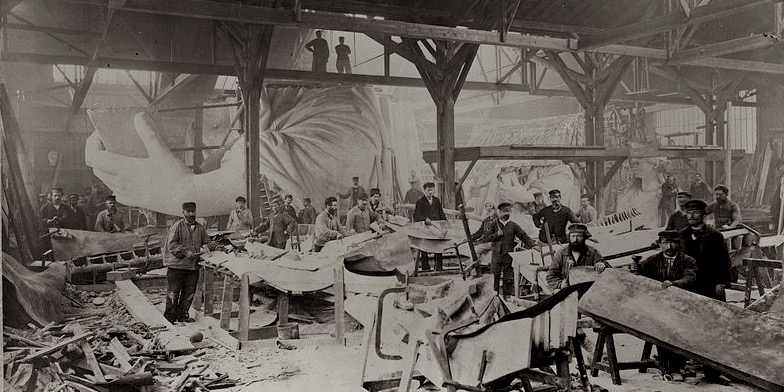 Statue of Liberty Workshop, photo Library of Congress
Statue of Liberty Workshop, photo Library of Congress
The Statue of Liberty was created due to the passion and work of French sculptor Frédéric Auguste Bartholdi. He was inspired by a casual remark made to him by French politician in 1865 (in the wake of the US Civil War) that perhaps there could be a monument to US independence as a joint project of the two nations.
Bartholdi was inspired by the idea and in the mid 1870s, before a statue was even designed, he created the head of a proposed statue along with an arm holding a torch. During the next decade Bartholdi promoted the project in both countries while trying to raise funds. The statue's monumental head was displayed at the Exposition Universelle held in Paris in 1878, while the arm holding the torch was shown at the US Centennial International Exhibition of 1876 in Philadelphia. (Shown in the photo above.)
With money raised and an island in New York Harbor made available, Bartholdi recruited the workshop of Gustave Eiffel to construct the internal structure for the 46-metre-high statue. Eiffel created an innovative double skeleton that would allow the statue to move in the wind and expand in heat without the skin cracking.
![]()
Find Hotel Deals for Your Dates in Paris
Check the complete list of Paris hotels to find current sale prices on rooms in every arrondissement. Save 10%, 20%… or even more! |
Paris Hotel Deals |
Find Hotel Deals for Your Dates in Paris
Save on hotels in every arrondissement of Paris – the Latin Quarter, Saint Germain, the Right Bank, the Marais, near the Eiffel Tower. Save 10%, 20%… or even more! |
![]()
Bartholdi built the entire statue and then disassembled it for transportation and rebuilding on Liberty Island, where it was dedicated in 1886.
The statue itself was created in the metalwork foundry of Gaget, Gauthier & Co, located at 25 Rue de Chazelles in the 17th Arrondissement, just steps away from Metro Courcelles, which serves Parc Monceau. The foundry is long gone, replaced by a modern five-story building, but there is a commemorative plaque celebrating the birthplace of the Statue of Liberty. Inside the building, in the medical offices of La Clinique du Parc Monceau, you can find a small, cast replica of the statue, making it, perhaps a sixth example of Lady Liberty in the city where she was born.
![]()
Romantic Dinner Cruises In Paris
|
VIP Dinner Cruise with Bateaux Parisiens |
Dinner Cruise by Maxim's of Paris |
|
VIP Dinner Cruise with Bateaux Parisiens |
Statues of Liberty in Paris
1. Musée des Arts & Metiers
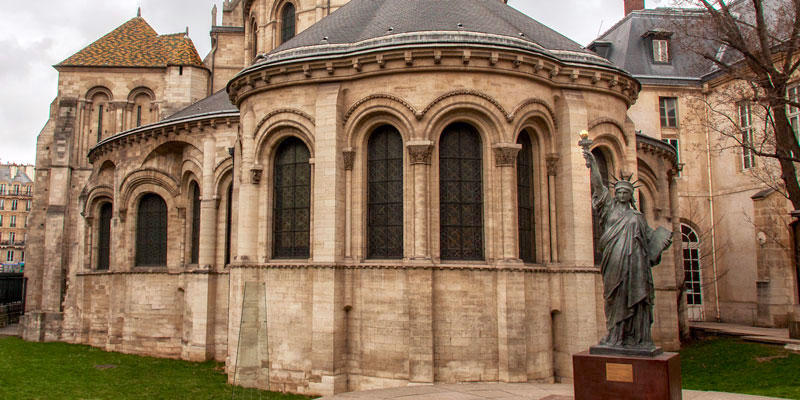 Musée des Arts & Metiers, photo by Mark Craft
Musée des Arts & Metiers, photo by Mark Craft
The Musée des Arts & Metiers, located at the top of the Marais, is housed in what was once the St-Martin-des-Champs priory and church. Outside, next to the apse of the chapel, is a small version of the Statue of Liberty. This is a bronze copy made from the original plaster model created by Bartholdi in 1878. In a sense, this is the first version of the statue.
2. Allée des Cygnes
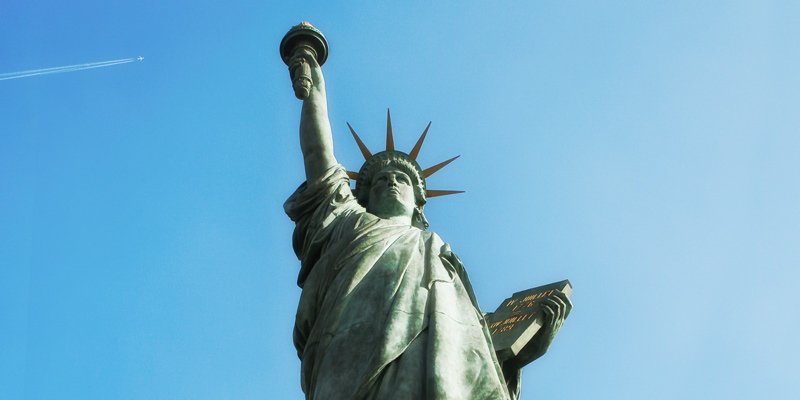 Statue of Liberty at Allée des Cygnes, photo by Mark Craft
Statue of Liberty at Allée des Cygnes, photo by Mark Craft
Allée des Cygnes is a small, long, and narrow island in the Seine, downstream from the Eiffel Tower. It's here that you can find a ¼-scale model of Lady Liberty given to France by US expats in Paris in 1889 to celebrate the 100th anniversary of the French Revolution. Oh the base of the statue two plaques mention July 4, 1776 and July 14, 1789.
The thin islet runs between two bridges — Pont de Bir-Harkeim and Pont de Grenelle. The Statue of Liberty is at the Grenelle end, the downstream end.
![]()
Our Most Popular Day Trips from Paris
|
Spend a Day in the Champagne Region |
Visit the Historic D-Day Beaches |
|
Visit the Historic D-Day Beaches |
3. Musée d'Orsay
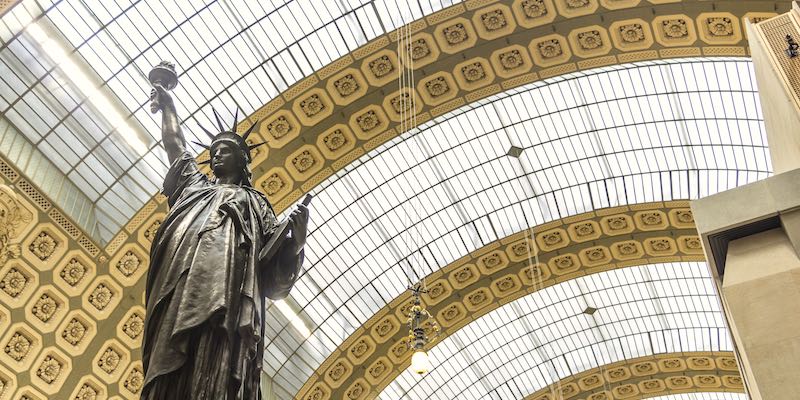 Statue of Liberty at Musée d'Orsay
Statue of Liberty at Musée d'Orsay
In the center of the main floor, greeting you as you arrive at this fantastic Impressionist museum, is another copy of the Statue of Liberty. This is a small version, created by Bartholdi himself for the Paris Exposition Universelle of 1900. Interestingly, the sculptor later gave the statue to the Musée du Luxembourg when that museum was home to 19th-century French art. Later it was located into the Jardin du Luxembourg. It was only in 2014 that it was moved into Musée d'Orsay.
4. Jardin du Luxembourg
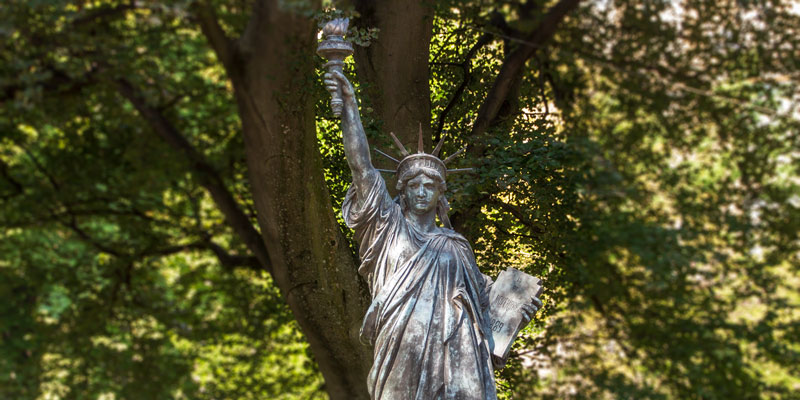 Statue of Liberty in Jardin du Luxembourg, photo by Mark Craft
Statue of Liberty in Jardin du Luxembourg, photo by Mark Craft
But the Jardin du Luxembourg was not without its own Statue of Liberty for very long. Once again the American ex-pats of Paris presented the city with a copy of the statue.
This Statue of Liberty stands in front of an oak tree. Beneath is a plaque that reads: "This American oak is dedicated to the memory of the victims of September 11, 2001 in the United States of America. Gift of the American community of Paris as a symbol of Franco-American friendship by M. Christian Poncelet, President of the French Senate in the presence of Honorable Howard Leach, Ambassador of the United States of America to France."
![]()
Skip-the-Line at the Louvre Museum
|
The Louvre's Greatest Masterpieces |
Louvre Skip-the-Line Tour |
|
The Louvre's Greatest Masterpieces |
5. Pont de l'Alma
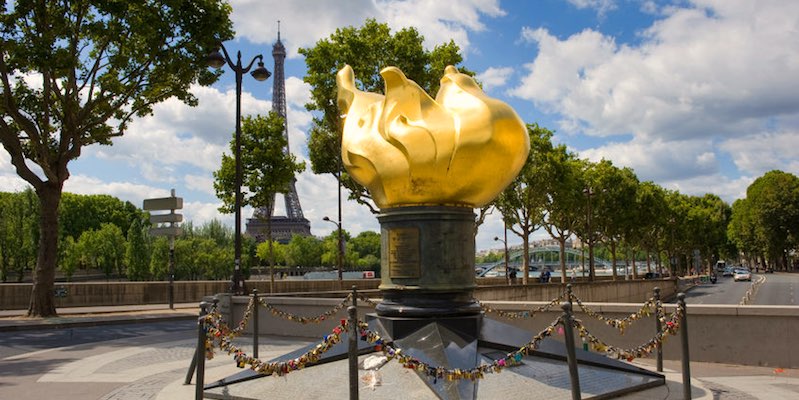 The gold flame of Liberty at Pont de l'Alma
The gold flame of Liberty at Pont de l'Alma
On the Right Bank side of this bridge (that affords a lovely view of the Eiffel Tower) is a replica of the gold flame that tops the Statue of Liberty. This was given to Paris in 1986 to celebrate the 100th anniversary of the dedication of the statue in New York Harbor. Today, many think of this as a memorial to Princess Diana, who was killed in a crash in the tunnel that runs beneath the bridge at this point in 1997. Flowers and other mementos dedicated to her can still be found here.
Paris Planning Guides
 Glorious Dinner Cruises
Glorious Dinner Cruises |
 Latin Quarter Hotels
Latin Quarter Hotels |
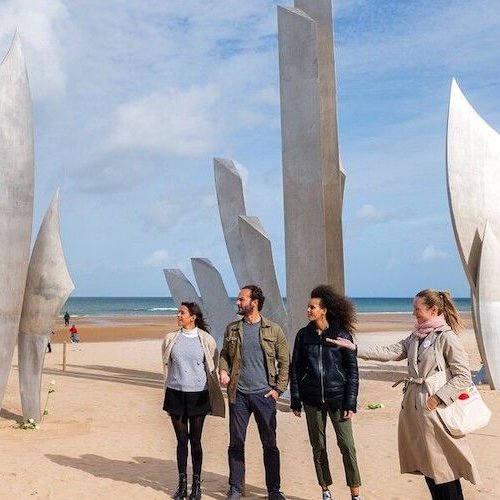 Historic D-Day Tours
Historic D-Day Tours |
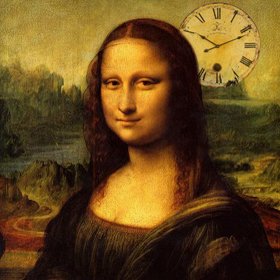 Skip-the-line Louvre Tour
Skip-the-line Louvre Tour |













